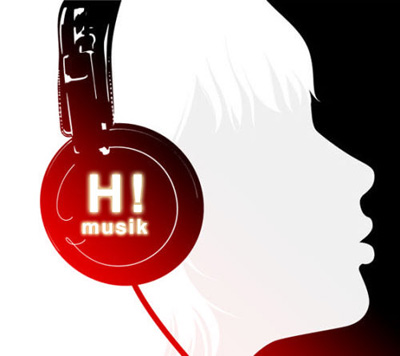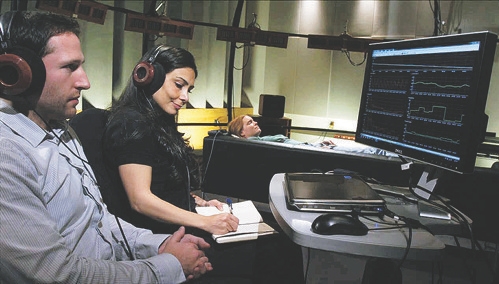 Âm nhạc là loại “âm thanh ma quái” thu hút biết bao người, từ các chính khách như TT Clinton cũng biết thổi kèn saxon, cựu Ngoại Trưởng C.Rice là tay dương cầm trứ tuyệt, đến tài tử Frank Sinatra mê hát hơn..mê vợ!
Âm nhạc là loại “âm thanh ma quái” thu hút biết bao người, từ các chính khách như TT Clinton cũng biết thổi kèn saxon, cựu Ngoại Trưởng C.Rice là tay dương cầm trứ tuyệt, đến tài tử Frank Sinatra mê hát hơn..mê vợ!
Một bài báo mới đây đăng trên tờ báo Nature Neuroscience đã đi bài do hai nhà nghiên cứu Robert Zatorre và Valorie Salimpoor thuộc đại học McGill của Montreal cắt nghĩa tại sao âm nhạc lại được nhiều nền văn hóa trên thế giới mê mẫn như thế.
Theo họ thì chính một hóa chất tiết ra trong não khi bạn nghe một đoản hòa âm thượng thặng của Beethoven, ăn một bữa ăn ưa thích ngon hay đang “hành sự du dương” với bạn tình. Hóa chất đó là dopamine.
Dopamine được tiết ra khi người nghe đang ‘đón chờ và tưởng tượng trước một đoạn nhạc cực kỳ hấp dẫn và người nghe vẫn cảm thấy ‘rần rần’ khi khúc nhạc đó đã chạy qua hai tai và đã chìm trong im lặng sau đó’
Trước đây người ta biết là dopamine đã có vai trò khi hai người thương mến nhau nói chuyện với nhau nhưng bảng khảo sát khoa học mới nhất cho thấy dopamine đã tiết ra trực tiếp khi con người tiếp xúc với âm nhạc.
Cuộc thí nghiệm chỉ diễn ra với các khí cụ âm nhạc, cho thấy giọng hát không cần thiết để kích thích dopamine. Bà Salimpoor cho là sau này cần phải có các công trình khảo sát thêm để xem liệu giọng hát du dương hay đặc biệt nào có thể gây tác động lên phản ứng ‘đê mê’ nơi người nhận hay không.
Các nhà khoa học lựa ra 8 người tình nguyện vì họ có đặc điểm khi nghe những đoản nhạc hòa âm ưa thích, họ cảm thấy êm dịu trong lòng để đo đạc và chụp ảnh não bộ của họ. Trí óc đã ‘phản ứng để đón chờ, tưởng tượng và cảm nhận thực thụ khi bản nhạc ập đến’ đều được các khoa học gia theo dõi.
Zatorre cho biết kết quả đo đạc chứng tỏ ngay cả những người thích nghe nhạc nhưng không thấy êm dịu vẫn tiết ra dopamine trong não. Vùng trong não gọi là ‘striatum’ là nơi tiết ra dopamine mạnh nhất khi nghe những bản nhạc đặc biệt yêu thích.
Máy theo dõi hoạt động của não MRI cho thấy một nơi của thùy striatum tiết ra dopamine trong vòng 15 giây khi não ‘biết đoạn nhạc hay sắp xuất hiện’, rồi một nơi khác lại tiết ra hóa chất này khi đoạn nhạc này thật sự xuất hiện’
Zatorre cho là chuyện này rất hữu lý, đó là vùng của não bộ có ảnh hưởng với sự phỏng đoán đã có liên lạc với những vùng khác cũng có chức năng phản ứng với tác nhân bên ngoài đưa vào, trong lúc vùng phản ứng với ‘giây phút tuyệt đỉnh’ lại liên lạc với hệ thần kinh đối giao cảm, vốn hoạt động trong các xúc động.
Những người tình nguyện đã lựa nhiều loại nhạc khác nhau, từ jazz đến cổ điển, nhạc punk, tango và ngay cả bagpipes. Các đoạn nhạc làm dopamine tiết ra nhiều nhất là Adagio for Strings của Barber, bản Giao Hưởng số 9 của Beethoven và Claire De Lune của Debussy.
Các nhà khảo sát còn cho là không những chỉ có âm nhạc làm con người sung sướng, mà tất cả những hình thức nghiên cứu nghệ thuật khác cũng có tác dụng tương tự.
Các bậc phụ huynh nên khuyến khích con em học nhạc hay bất cứ môn nghệ thuật nào để cuộc sống tinh thần của chúng được thăng hoa, có khi lại giúp con học giỏi nữa…
Hồng Quang
Music produces a natural high, McGill study finds Neurotransmitter dopamine is released when people listen to favourite tunes

Researcher Valorie Salimpoor and colleague Mitchel Benovoy observe a volunteer as she listens to some of her favourite music
Music triggers the same pleasure-reward system in the brain as food, sex and illicit drugs, according to McGill University researchers who have been peering into minds of music lovers.
They’ve discovered the feel-good neurotransmitter dopamine is released when people listen to their favourite music, be it rock, jazz or classical.
The finding by the team at McGill, reported yesterday in the journal Nature Neuroscience, helps explain why music is so pleasurable and popular.
It also hints at why music has been so valued and important throughout human history and across cultures, says neuroscientist Robert Zatorre, who leads the McGill team at the Montreal Neurological Institute.
“Music has such deep roots in the brain that it engages this biologically ancient system,” says Zatorre, explaining how dopamine generates the sensation of pleasure in the striatum, a primitive region deep in the brain.
It’s long been known dopamine is produced and generates pleasure when we eat or have sex, reinforcing activities that are key to survival. The Montreal study provides the first evidence that dopamine is also responsible for musical highs.
“For reasons that we don’t entirely understand, somehow music was able to kick in with the same system,” Zatorre says. “And that gives it power that it might not otherwise have.”
While music may not be key to survival, he says it has been “very” useful.
“Because it gives us pleasure, we can use it to our advantage to modulate our state of mind.”
Heroin and cocaine hijack the dopamine system, which is what makes the illicit drugs so addictive. But Zatorre sees little danger in listening to too much music.
“If you are hooked on music, it won’t cause you to waste away, it won’t give you health problems,” he says. “On the contrary, it probably enhances your health.”
For the study, he and his colleagues put out a call for people who get the chills, a sign of intense nervous-system arousal, when listening to music. Of the more than 200 individuals who volunteered, 10 people were eventually selected to undergo the brain scans that cost a few thousand dollars each.
One key stipulation was that the volunteers’ favourite music not have lyrics. “We wanted to be sure the response was due to the music, not the words that accompanied it,” Zatorre says.
The volunteers agreed to undergo brain scans while listening to tunes they picked, which ranged from techno to folk to classical.
Two types of brain scans were done as the volunteers blissed out to music inside the medical machines. Positron emission tomography (PET) revealed if and where dopamine was being released. For these scans, the volunteers were injected with a short-lived and harmless radioactive molecule, carbon-11, that latched onto any dopamine produced and showed up on the PET scans.
Magnetic resonance imaging (MRI), which detects how much oxygen brain cells are using, revealed which areas of the brain were stimulated as the pleasure associated with the music kicked in. “It tells us where the brain is active and it tells us, within a range of a couple of seconds or so, when it is active,” Zatorre says.
The music that generated dopamine release depended on the listeners’ tastes and preferences.
“All types of music activated the same part of the brain,” Zatorre says. “It doesn’t matter if it’s punk, classical, tango or even bagpipes.”
While the study volunteers experienced the chills when most roused by music, he says the scans revealed dopamine was also released even when the pleasure was not as intense.
The scans also showed that dopamine is released in advance of key sections and sequences in music, enhancing and prolonging the pleasure, which Zatorre considers one of the most interesting findings: “Ten to 20 seconds prior to the maximum pleasure, there was a different dopamine response in a slightly different place in the brain.”
He says this “anticipation response” helps explain why musicians often build tension and pauses into their pieces. “They have a kind of intuitive understanding of the neuro-mechanisms behind pleasure,” Zatorre says.
He says understanding the biochemical orchestra at work in the “magic of music” makes him appreciate it even more.
Visit www.zlab.mcgill.ca/home.htmlfor a sample of chill-inducing music.
Source: MARGARET MUNRO — The Montreal Gazette










































